Research and Experimental Application of New Slurry Proportioning for Slag Improvement of EPB Shield Crossing Sand and Gravel Layer
Abstract
:1. Introduction
2. Study on Properties of New Mud Modifier
2.1. Site Mud Solution
2.2. New Mud Solution
2.3. Comparative Study on Mud Performance after Adding Different Additives
2.3.1. Viscosity Contrast
2.3.2. Dynamic Shear Force Comparison
2.3.3. Static Shear Force Comparison
2.3.4. Dynamic Plastic Ratio Comparison
2.3.5. Flowability Index and Consistency Coefficient Comparison
2.3.6. API Filtration Loss Comparison
2.4. Comprehensive Analysis of Mud Plan
2.5. Effect of Clay Particles on Mud Properties
3. Analysis of Indoor Muck Improvement Test
3.1. Soil Mixing Test Design
- (1)
- Use a plastic measuring cup to measure a certain volume of soil and pour it into the mixer, stir for 3 min, stop stirring after the reading of the power meter is stable, and record the stirring power when the reading is stable.
- (2)
- Take out a certain amount of soil from the mixing tank and conduct the friction coefficient test, adhesion resistance test, and slump test in sequence.
- (3)
- Pour the test soil back into the mixer, add a certain amount of soil amendment, stir the soil with a mixer for soil improvement, stir for 3 min and stop stirring after the reading of the power meter is stable. Record the stirring power when the reading is stable, and then remove the soil from the mixing drum for subsequent tests. The test cannot be terminated until the soil reaches the ideal plastic flow state. There were 3–5 groups in each experiment, and the results were averaged.
3.2. Friction Coefficient Test Design
- (1)
- Place the plastic ring on a stainless-steel plate, fill it with improved soil, and smooth the top of the plastic ring.
- (2)
- Fix one end of the steel plate, and slowly lift the other end. When the ring with the improved soil starts to slide, stop and continue to lift.
- (3)
- The angle at which the steel plate is tilted at this time is measured, which is the external friction angle between the improved soil and the steel plate.
- (4)
- The friction coefficient between the improved soil and the steel plate can be obtained by the following formula. There were 3–5 groups in each experiment, and the results were averaged.
3.3. Adhesion Resistance Test
- (1)
- Place the iron cylinder on the iron box, fill it with the improved soil, and smooth the upper part of the improved soil.
- (2)
- Lift the iron cylinder slowly, and stop lifting the iron cylinder when the iron cylinder is high enough.
- (3)
- Measure the adhesion resistance F at this time, which is the adhesion resistance between the improved soil and the iron cylinder.
- (4)
- After the adhesion resistance between the improved soil and the iron cylinder is measured, this does not provide the adhesion resistance between the reaction soil and the iron surface used, because this adhesion resistance only reflects the situation of this test. Therefore, this adhesion resistance should also be treated to a certain extent, obtaining the size of the adhesion resistance per unit area, to better reflect the change in the adhesion resistance between the soil and the iron cylinder. There were 3–5 groups in each experiment, and the results were averaged. The adhesion resistance coefficient k is obtained by the following formula. This adhesion resistance measuring device is shown in Figure 9.
3.4. Slump Test Design
4. Results of Soil Improvement Test
4.1. Experimental Study on Improvement of Pebble/Gravel Soil
4.1.1. Slump Test Design
4.1.2. Friction Coefficient Test
4.1.3. Adhesion Resistance Test
4.1.4. Slump Test
4.2. Experimental Study on Sandy Soil Improvement
4.2.1. Sand Mixing Test
4.2.2. Sand Friction Coefficient Test
4.2.3. Sand Adhesion Resistance Test
4.2.4. Sand Slump Test
5. Conclusions
- (i)
- Through laboratory tests, the effects of guar gum, CMC, xanthan gum, and polyacrylamide, which are different additives, on the performance of the slurry are analyzed with bentonite as the base slurry. It was found that xanthan gum was the best material to improve the performance of the slurry. The best slurry preparation scheme is 4% bentonite, 0.2% xanthan gum, 0.04% soda ash, and 1% clay particles.
- (ii)
- Through indoor simulated muck improvement tests (mixing test, slump test, slide plate test, and adhesion resistance test), the improvement effects of applying new mud and ordinary mud in pebble/round gravel and sandy soil layers were compared to verify the superiority of the new mud in the application of the above two kinds of formations.
- (iii)
- In the soil improvement test, the effect of the new mud was similar to that of ordinary mud. However, it had greater advantages in improving the two parameters of the soil adhesion resistance coefficient and slumps during shield tunneling.
- (iv)
- When used to improve pebble/round gravel soil, the test showed that when the net power was close to 0, the slag soil was in a good flow plastic state, and the net power of the new mud was less than that of the mud used in the construction site. When the friction angle was about 20°, the flow plasticity of slag was better. When the mud dosage was 28%, the friction coefficient of the new mud was smaller than that of the land mud. When the amount of mud was about 28%, the adhesion resistance coefficient had a low, stable value, and the adhesion resistance coefficient of the new mud was smaller than that of the mud used in the construction site. When the amount of mud added was 28%, the slump of the mud used at the construction site was only 7.5 cm, which cannot meet the requirements of the earth pressure balance shield on the slump of the muck, while the slump of the new mud was 18 cm, which meets the requirements.
- (v)
- When used to improve the sand, the test found that when the amount of mud added was 32%, the net mixing power of the new mud was 0.002 KW, indicating that the sand was in a good flow plastic state, while the net mixing power of the mud used at the construction site is 0.009, which is significantly greater than the new mud. When the amount of mud added was 32%, the friction coefficient of the new mud was 0.29, which meets the requirements of flow plasticity. The site mud rose to the maximum value of 0.62, and then the friction coefficient decreased to 0.36 as the amount of mud added reached 44%. When the new mud dosage was 32%, the mud was in the flow plastic state, while when the mud dosage was 32%, the adhesion resistance reached the maximum value, and when the mud dosage reached 44%, the sand was in the flow plastic state. When the dosage of new mud was 32%, the slump was 18 cm, meeting the requirements. When the amount of mud used at the construction site was 44%, the slump reached 16 cm.
- (vi)
- The new mud addition ratio was 28% for improved pebble/round gravel soil, and 32% for improved sand and clay. By comparison, it can be seen that the new mud is more suitable for improved pebble/round gravel soil and meets the requirements for the improvement of sandy pebble stratum.
Author Contributions
Funding
Institutional Review Board Statement
Informed Consent Statement
Data Availability Statement
Conflicts of Interest
References
- He, C.; Feng, K.; Fang, Y. Review and prospects on constructing technologies of metro tunnels using shield tunnelling method. J. Southwest Jiaotong Univ. 2015, 50, 97–109. [Google Scholar]
- Qingke, N.; Guang, S.; Siyuan, G.; Hongtao, L.; Lichao, Z.; Jianpeng, H. Disturbance Process of Sandy Gravel Stratum Caused by Shield Tunneling and Ground Settlement Analysis. Front. Earth Sci. 2021, 9, 994. [Google Scholar] [CrossRef]
- Hasheminezhad, A.; Farzalizadeh, R.; Rahimi, H.; Bahadori, H. Seismic performance assessment of wall-type gravel and rubber drains in liquefaction mitigation of sands. Bull. Earthq. Eng. 2022, 20, 3699–3714. [Google Scholar] [CrossRef]
- Zhao, J.S.; Jiang, Q.; Lu, J.F.; Chen, B.R.; Pei, S.F.; Wang, Z.L. Rock fracturing observation based on microseismic monitoring and borehole imaging: In situ investigation in a large underground cavern under high geostress. Tunn. Undergr. Space Technol. 2022, 126, 104549. [Google Scholar] [CrossRef]
- Chen, Z.T.; Bezuijen, A.; Fang, Y.; Wang, K.; Deng, R.Y. Experimental study and field validation on soil clogging of EPB shields in completely decomposed granite. Tunn. Undergr. Space Technol. 2022, 120, 104300. [Google Scholar] [CrossRef]
- Wang, H.B.; Wang, S.Y.; Zhong, J.Z.; Qu, T.M.; Liu, Z.R.; Xu, T.; Liu, P.F. Undrained compressibility characteristics and pore pressure calculation model of foam-conditioned sand. Tunn. Undergr. Space Technol. 2021, 118, 104161. [Google Scholar] [CrossRef]
- Farzalizadeh, R.; Hasheminezhad, A.; Bahadori, H. Shaking table tests on wall-type gravel and rubber drains as a liquefaction countermeasure in silty sand. Geotext. Geomembr. 2021, 49, 1483–1494. [Google Scholar] [CrossRef]
- Dai, C.Q.; Sui, H.T.; Ma, C. Study on the Ultimate Supporting Force of Shield Excavation Face Based on Anisotropic Strength Theory. Appl. Sci. 2020, 10, 5222. [Google Scholar] [CrossRef]
- Hasheminezhad, A.; Bahadori, H. Seismic response of shallow foundations over liquefiable soils improved by deep soil mixing columns. Comput. Geotech. 2019, 110, 251–273. [Google Scholar] [CrossRef]
- Zhao, J.S.; Chen, B.R.; Jiang, Q.; Lu, J.F.; Hao, X.J.; Pei, S.F.; Wang, F. Microseismic Monitoring of Rock Mass Fracture Response to Blasting Excavation of Large Underground Caverns Under High Geostress. Rock Mech. Rock Eng. 2022, 55, 733–750. [Google Scholar] [CrossRef]
- Liang, X.; Ye, F.; Ouyang, A.H.; Han, X.; Qin, X.Z. Theoretical Analyses of the Stability of Excavation Face of Shield Tunnel in Lanzhou Metro Crossing beneath the Yellow River. Int. J. Geomech. 2020, 20, 04020200. [Google Scholar] [CrossRef]
- Sui, H.T.; Ma, C.; Dai, C.Q.; Yang, T.Z. Study on Stability of Shield Tunnel Excavation Face in Soil-Rock Composite Stratum. Math. Probl. Eng. 2021, 2021, 5579103. [Google Scholar] [CrossRef]
- Huang, X.; Li, L.F.; Zhang, C.F.; Liu, B.; Li, K.J.; Shi, H.B.; Jing, B.Y. Multi-Step Combined Control Technology for Karst and Fissure Water Inrush Disaster During Shield Tunneling in Spring Areas. Front. Earth Sci. 2021, 9, 795457. [Google Scholar] [CrossRef]
- Liu, P.F.; Wang, S.Y.; Ge, L.; Thewes, M.; Yang, J.S.; Xia, Y.M. Changes of Atterberg limits and electrochemical behaviors of clays with dispersants as conditioning agents for EPB shield tunnelling. Tunn. Undergr. Space Technol. 2018, 73, 244–251. [Google Scholar] [CrossRef]
- Liu, W.; Shi, P.X.; Yu, M.; Jia, P.J. Analysis of working face stability during obstruction removal from a box tunnel machine. Acta Geotech. 2022, 17, 4627–4639. [Google Scholar] [CrossRef]
- Zizka, Z.; Schoesser, B.; Thewes, M. Investigations on the transient support pressure transfer at the tunnel face during slurry shield drive Part 2: Case B-Deep slurry penetration exceeds tool cutting depth. Tunn. Undergr. Space Technol. 2021, 118, 104169. [Google Scholar] [CrossRef]
- Newton, R.C. A Geo-Experimental Diagram for Garnet Amphibolite and Its Bearing on the Origin of Continents. J. Geol. 2018, 126, 531–539. [Google Scholar] [CrossRef]
- Tomiczek, T.; Prasetyo, A.; Mori, N.; Yasuda, T.; Kennedy, A. Physical modelling of tsunami onshore propagation, peak pressures, and shielding effects in an urban building array. Coast. Eng. 2016, 117, 97–112. [Google Scholar] [CrossRef] [Green Version]
- Zhu, C.H.; Wang, S.H.; Peng, S.; Song, Y.L. Surface settlement in saturated loess stratum during shield construction: Numerical modeling and sensitivity analysis. Tunn. Undergr. Space Technol. 2022, 119, 104205. [Google Scholar] [CrossRef]
- Yu, H.J.; Mooney, M.; Bezuijen, A. A simplified excavation chamber pressure model for EPBM tunneling. Tunn. Undergr. Space Technol. 2020, 103, 103457. [Google Scholar] [CrossRef]
- Cui, G.; Cui, J.; Fang, Y.; Chen, Z.T.; Wang, H.W. Scaled model tests on segmental linings of shield tunnels under earth and water pressures. Int. J. Phys. Model. Geotech. 2020, 20, 338–354. [Google Scholar] [CrossRef]
- Wang, S.Y.; Huang, S.; Zhong, J.Z.; Zhang, S.; Hu, Q.X.; Qu, T.M.; Ye, X.Y. Permeability stability calculation model of foam-conditioned soil based on the permeability constant. Int. J. Numer. Anal. Methods Geomech. 2021, 45, 540–559. [Google Scholar] [CrossRef]
- Zhang, P.; Chen, R.P.; Wu, H.N.; Liu, Y. Ground settlement induced by tunneling crossing interface of water-bearing mixed ground: A lesson from Changsha, China. Tunn. Undergr. Space Technol. 2020, 96, 103224. [Google Scholar] [CrossRef]
- Lee, H.; Kim, D.Y.; Shin, D.; Oh, J.; Choi, H. Effect of foam conditioning on performance of EPB shield tunnelling through laboratory excavation test. Transp. Geotech. 2022, 32, 100692. [Google Scholar] [CrossRef]
- Qu, T.M.; Wang, S.Y.; Hu, Q.X. Coupled Discrete Element-Finite Difference Method for Analysing Effects of Cohesionless Soil Conditioning on Tunneling Behaviour of EPB Shield. KSCE J. Civ. Eng. 2019, 23, 4538–4552. [Google Scholar] [CrossRef]
- Kou, L.; Zhao, J.J.; Miao, R.H.; Lian, F.L. Experimental Study on Dynamic Mechanical Characteristics of Mud Slurry Penetrating into Excavation Surface of Large Diameter Slurry Shield. Arab. J. Sci. Eng. 2022, 47, 13139–13150. [Google Scholar] [CrossRef]
- Ling, F.L.; Wang, S.Y.; Hu, Q.X.; Huang, S.; Feng, Z.Y. Effect of bentonite slurry on the function of foam for changing the permeability characteristics of sand under high hydraulic gradients. Can. Geotech. J. 2022, 59, 1061–1070. [Google Scholar] [CrossRef]
- Huang, Z.Q.; Wang, C.; Dong, J.Y.; Zhou, J.J.; Yang, J.H.; Li, Y.W. Conditioning experiment on sand and cobble soil for shield tunneling. Tunn. Undergr. Space Technol. 2019, 87, 187–194. [Google Scholar] [CrossRef]
- Liang, Y.; Huang, X.M.; Gao, S.J.; Yin, Y.H. Study on the Floating of Large Diameter Underwater Shield Tunnel Caused by Synchronous Grouting. Geofluids 2022, 2022, 2041924. [Google Scholar] [CrossRef]
- Qian, Y.J.; Min, F.L.; Mo, Z.Z.; Fan, X.H. Experimental Study of the Influence of Excavation Surface Stability and Sand Flowability Caused by Dense Slurry-Earth Pressure Balance Shield Tunneling in Silty Sand Stratum. Adv. Civ. Eng. 2020, 2020, 8883190. [Google Scholar] [CrossRef]
- Shevtsov, A.N.; Zhamaletdinov, A.A. Temperature and Rheological Parameters of the Baltic Shield Lithosphere from Electromagnetic Sounding Results. Izv. Atmos. Ocean. Phys. 2021, 57, 712–728. [Google Scholar] [CrossRef]
- Yang, Z.Y.; Yang, X.; Ding, Y.J.; Jiang, Y.S.; Shao, X.K.; Qi, W.Q.; Liu, N. Effect of Soil Conditioning on Saturated Sand Layers in EPB Shields: A Microstructural Analysis Based on CT Scanning and SEM. Arab. J. Sci. Eng. 2022, 47, 12387–12397. [Google Scholar] [CrossRef]
- Zhen, Z.; Ge, X.S.; Zhang, J. Soil Conditioning Tests on Sandy and Cobbly Soil for Shield Tunneling. KSCE J. Civ. Eng. 2021, 25, 1229–1238. [Google Scholar] [CrossRef]
- Milligan, G. Lubrication and Soil Conditioning in Tunnelling, Pipe Jacking and Microtunnelling: A State-of-the-Art Review; Geotechnical Consulting Group: London, UK, 2000. [Google Scholar]
- Wang, S.Y.; Liu, P.F.; Hu, Q.X.; Zhong, J.Z. Effect of dispersant on the tangential adhesion strength between clay and metal for EPB shield tunnelling. Tunn. Undergr. Space Technol. 2020, 95, 103144. [Google Scholar] [CrossRef]
- Zhao, S.S.; Li, S.C.; Wan, Z.; Wang, X.W.; Wang, M.L.; Yuan, C. Effects of anti-clay agents on bubble size distribution and stability of aqueous foam under pressure for earth pressure balance shield tunneling. Colloid Interface Sci. Commun. 2021, 42, 100424. [Google Scholar] [CrossRef]
- Wang, S.M.; Lu, X.X.; Wang, X.M.; He, C.; Xia, X.; Ruan, L.; Jian, Y.Q. Soil Improvement of EPBS Construction in High Water Pressure and High Permeability Sand Stratum. Adv. Civ. Eng. 2019, 2019, 4503219. [Google Scholar] [CrossRef] [Green Version]
- Zhu, H.H.; Cheng, P.P.; Zhuang, X.Y.; Li, Y.H.; Li, P.N. Assessment and and structural improvement on the performance of soil chamber system of EPB shield assisted with DEM modeling. Tunn. Undergr. Space Technol. 2020, 96, 103092. [Google Scholar] [CrossRef]
- Lee, H.; Choi, H.; Choi, S.W.; Chang, S.H.; Kang, T.H.; Lee, C. Numerical Simulation of EPB Shield Tunnelling with TBM Operational Condition Control Using Coupled DEM-FDM. Appl. Sci. 2021, 11, 2551. [Google Scholar] [CrossRef]
- Liu, B.; Li, T.; Han, Y.H.; Li, D.Y.; He, L.L.; Fu, C.Q.; Zhang, G. DEM-continuum mechanics coupling simulation of cutting reinforced concrete pile by shield machine. Comput. Geotech. 2022, 152, 105036. [Google Scholar] [CrossRef]
- Wu, L.; Qu, F.Z. Discrete element simulation of mechanical characteristic of conditioned sands in earth pressure balance shield tunneling. J. Cent. South Univ. Technol. 2009, 16, 1028–1033. [Google Scholar] [CrossRef]
- Cheng, C.; Liao, S.; Chen, L.; Fan, M.; Huo, X.; University, T. Experiments of Soil Conditioning for Shield Tunneling in Watery Quartz Sand-Gravel Ground. J. Shanghai Jiaotong Univ. 2018, 52, 1492. [Google Scholar]
- Shu-chao, Z.; Shao-hui, H.; Zi-peng, Z.; Cheng-hui, L. Research on soil conditioning for earth pressure balance shield tunneling in Lanzhou sandy pebble strata with rich water. Rock Soil Mech. 2017, 38, 279–286. [Google Scholar]
- Jiang, H.; Gong, Q.; Du, X. Experimental study on soil conditioning in cobble layer by use of earth pressure balanced machine. Chin. J. Geotech. Eng. 2013, 35, 284–292. [Google Scholar]
- Lee, H.Y.B.; Kwak, J.; Choi, J.; Hwang, B.; Choi, H. A lab-scale experimental approach to evaluate rheological properties of foam-conditioned soil for EPB shield tunnelling. Tunn. Undergr. Space Technol. 2022, 128, 104667. [Google Scholar] [CrossRef]
- Zhao, S.S.; Li, S.C.; Wan, Z.; Wang, M.L. Dispersant for Reducing Mud Cakes of Slurry Shield Tunnel Boring Machine in Sticky Ground. Adv. Mater. Sci. Eng. 2021, 2021, 5524489. [Google Scholar] [CrossRef]
- Xiao, C.; Tan, L.; Chen, R.; Zhong, Z.; Yang, J. Dynamic coupling simulation of shield construction mechanics considering characteristics of soils. Chin. J. Geotech. Eng. 2019, 41, 1108–1115. [Google Scholar]
- Xu, Q.W.; Zhang, L.Y.; Zhu, H.H.; Gong, Z.Y.; Liu, J.G.; Zhu, Y.H. Laboratory tests on conditioning the sandy cobble soil for EPB shield tunnelling and its field application. Tunn. Undergr. Space Technol. 2020, 105, 103512. [Google Scholar] [CrossRef]
- Li, L.P.; Sun, S.Q.; Wang, J.; Yang, W.M.; Song, S.G.; Fang, Z.D. Experimental study of the precursor information of the water inrush in shield tunnels due to the proximity of a water-filled cave. Int. J. Rock Mech. Min. Sci. 2020, 130, 104320. [Google Scholar] [CrossRef]
- Wang, L.; Zhu, W.; Qian, Y.J.; Xu, C.; Hu, J.N.; Xing, H.T. Phenomenon and Critical Conditions of Chamber Soil Sliming during EPB Shield Tunneling in Water-Rich Weathered Diorite: Case Study of Jinan Metro, China. Adv. Civ. Eng. 2020, 2020, 6530832. [Google Scholar] [CrossRef]
- Wei, Y.J.; Zheng, X.; Su, F.; Li, M.M.; Li, F.; Yang, Y.Y. Evaluation of Cutting Tool Wear of Earth Pressure Balance Shield in Granular Soil Based on Laboratory Test. J. Test. Eval. 2019, 47, 927–941. [Google Scholar] [CrossRef]
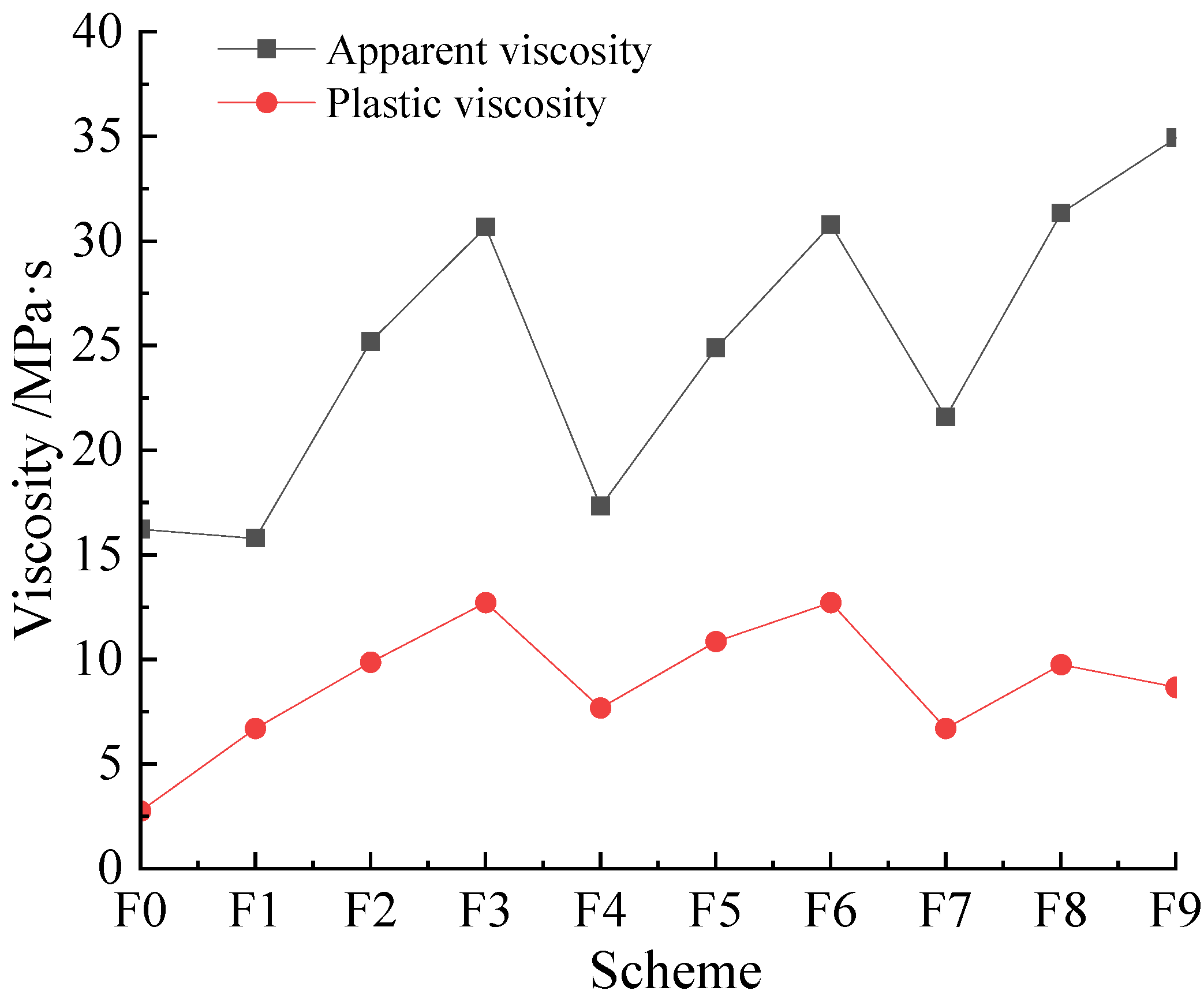
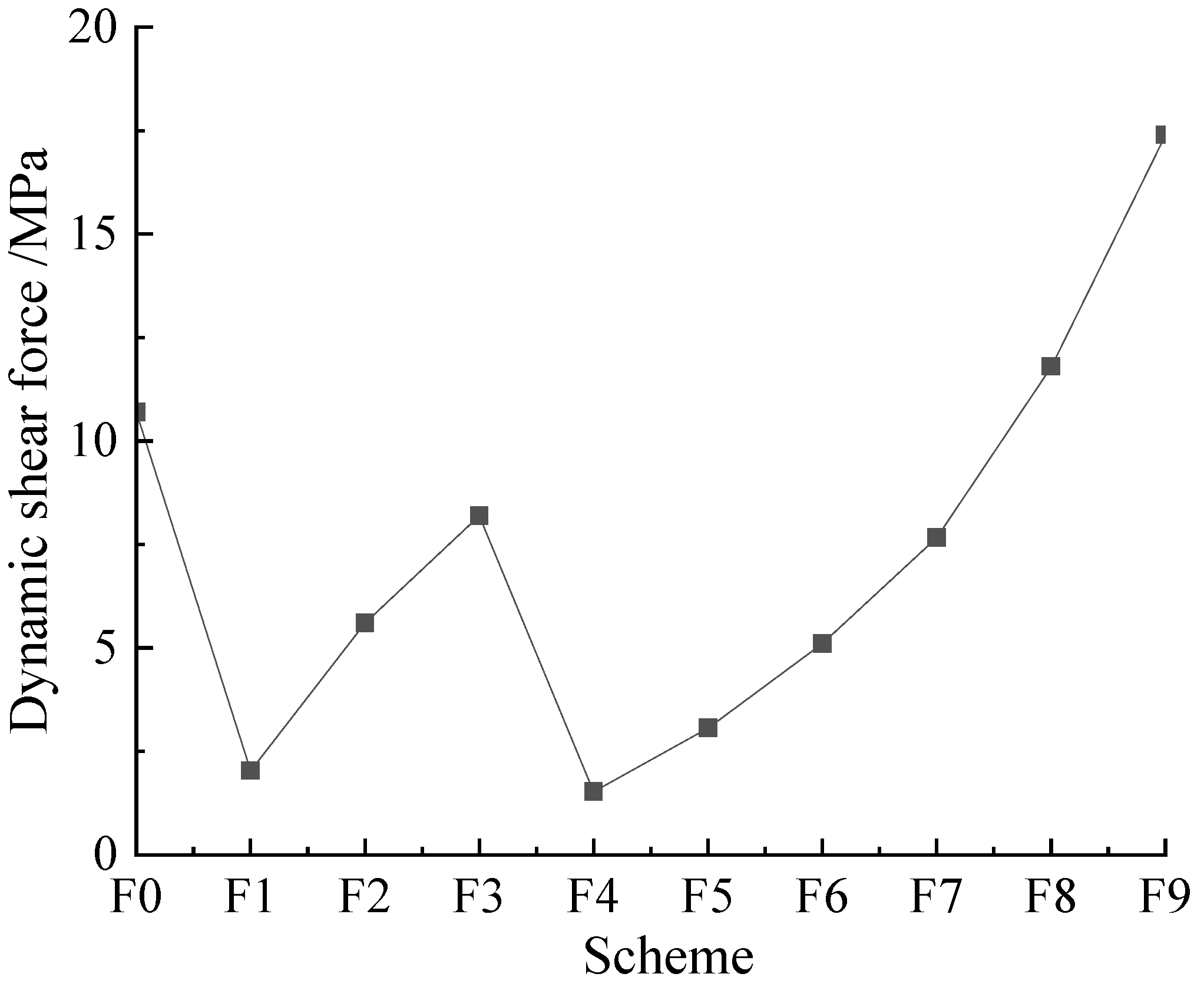
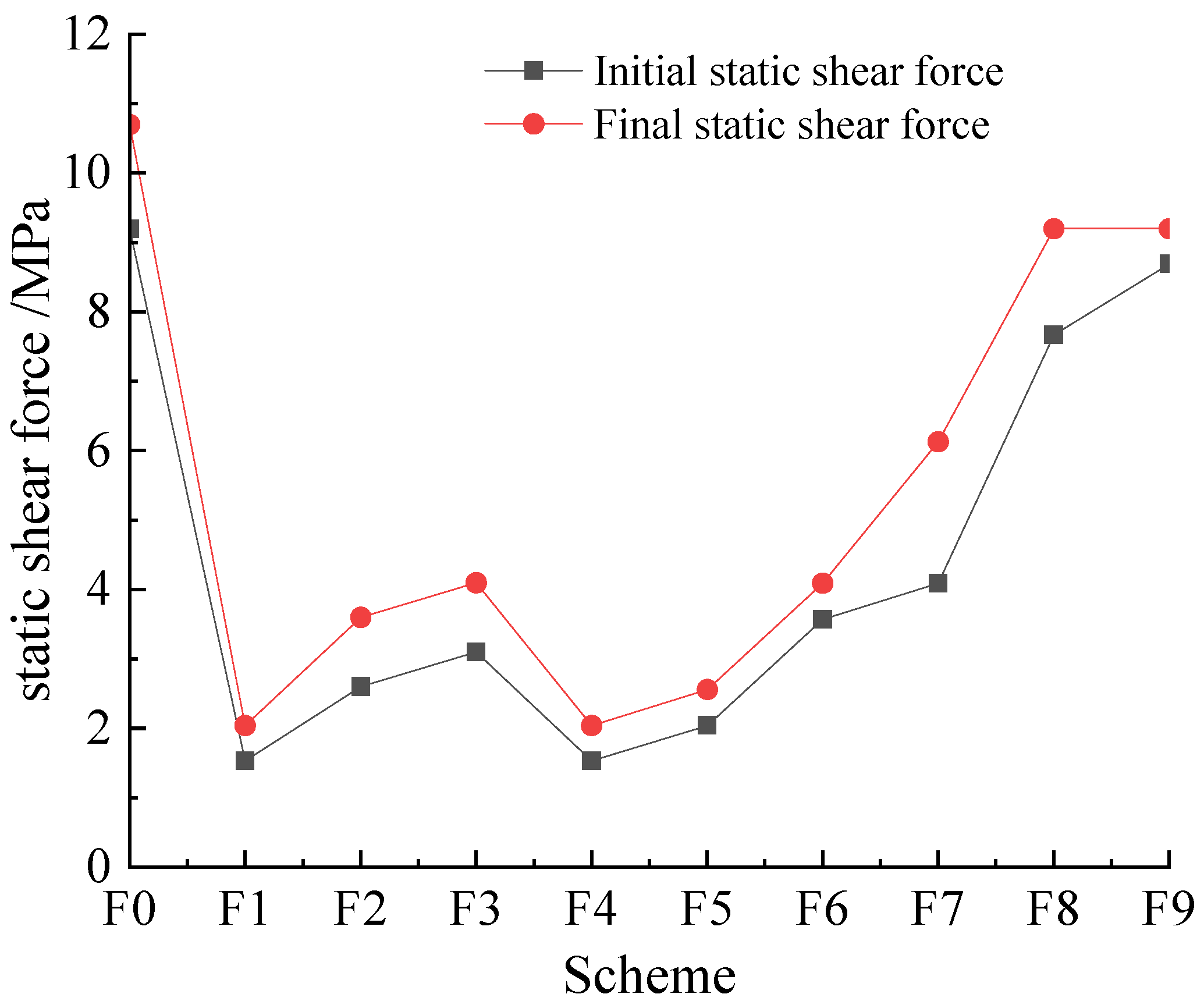
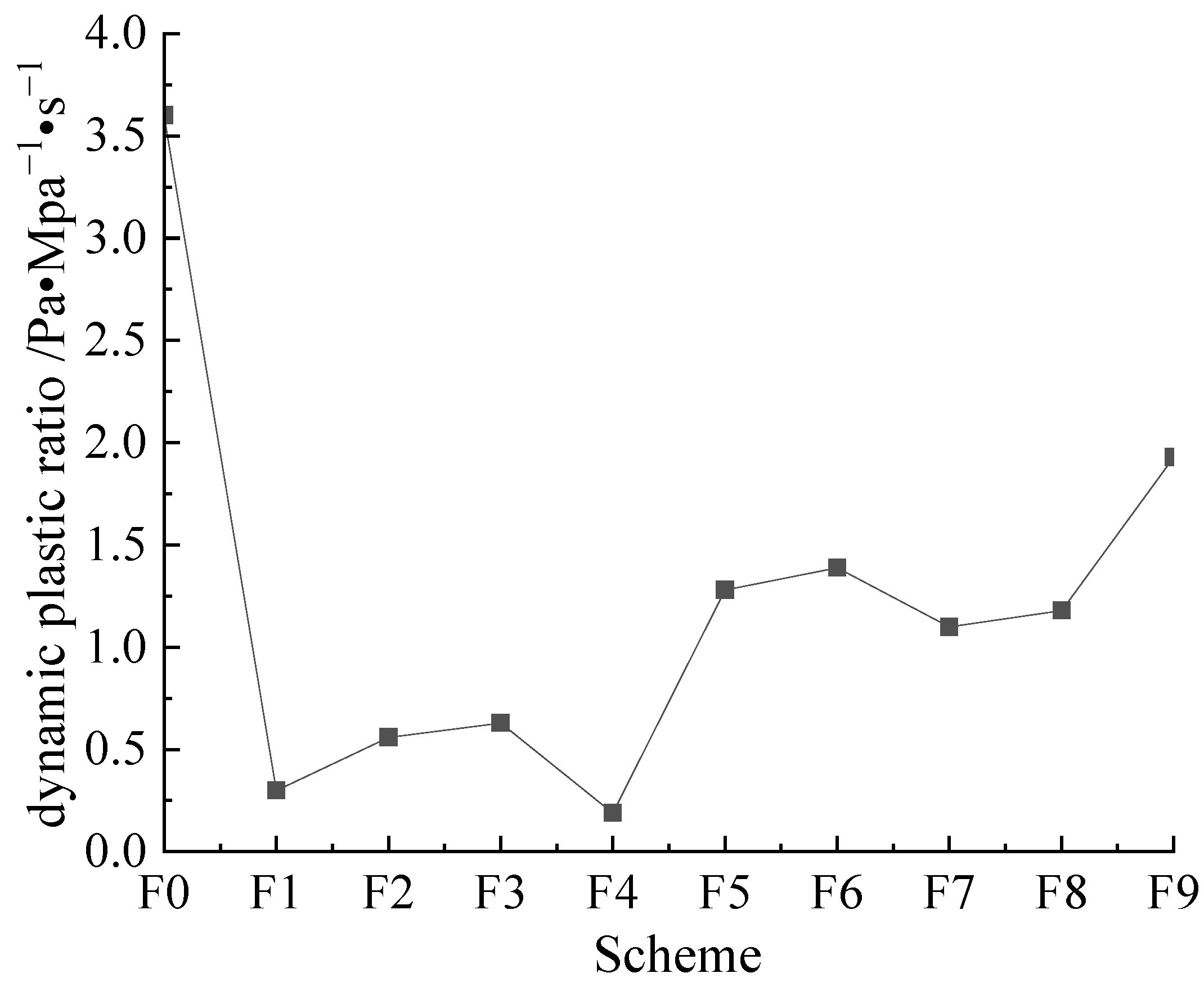
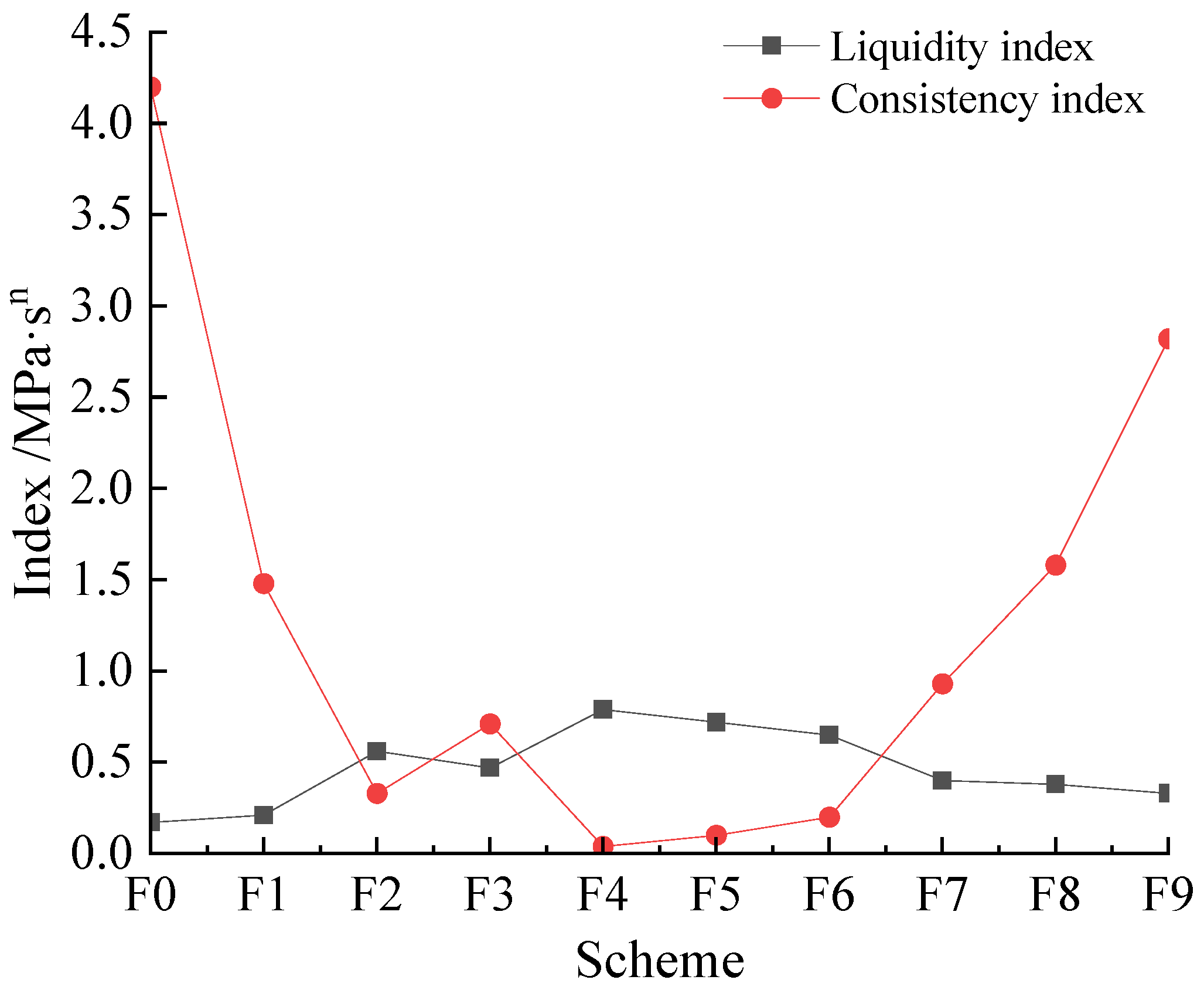
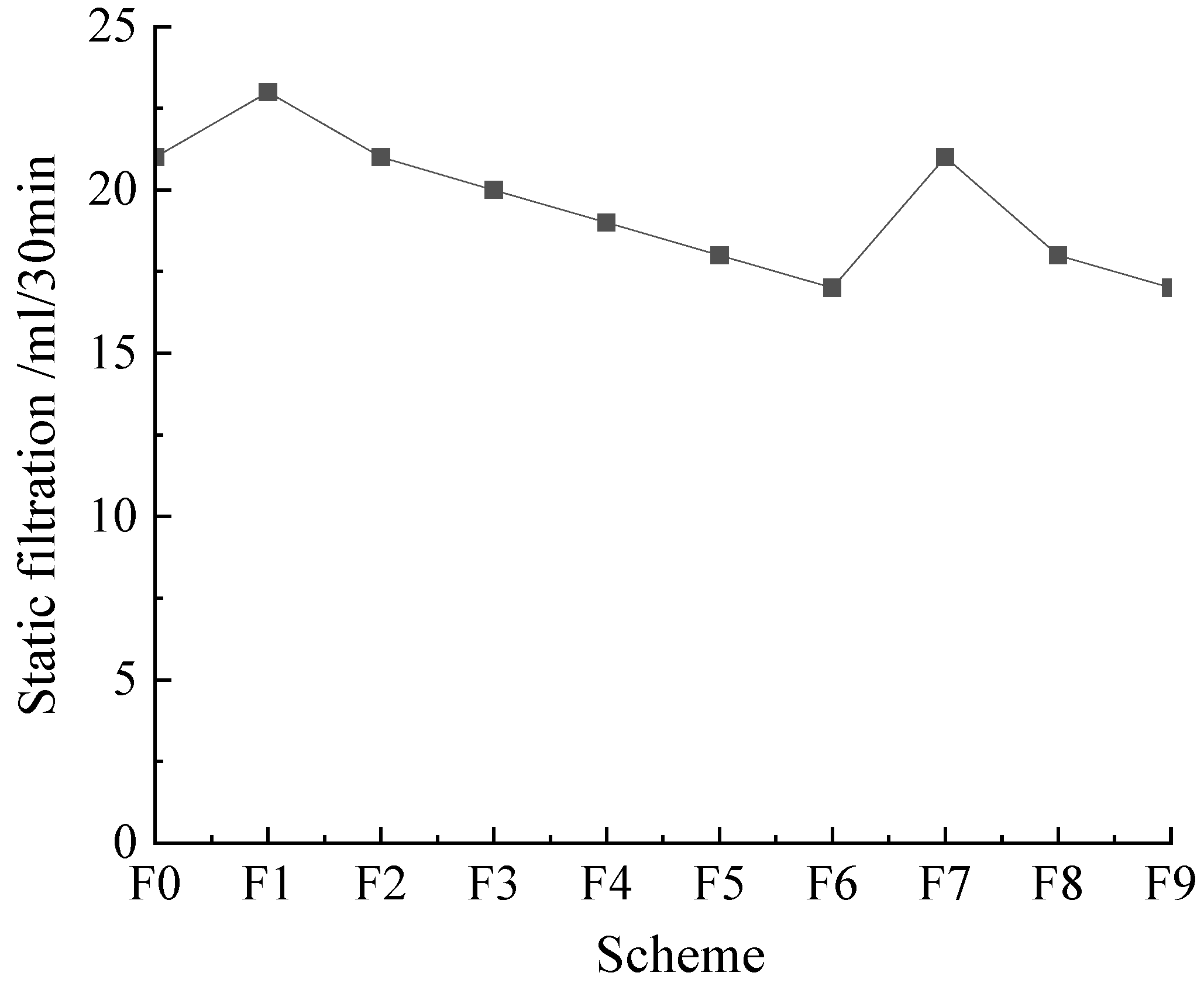
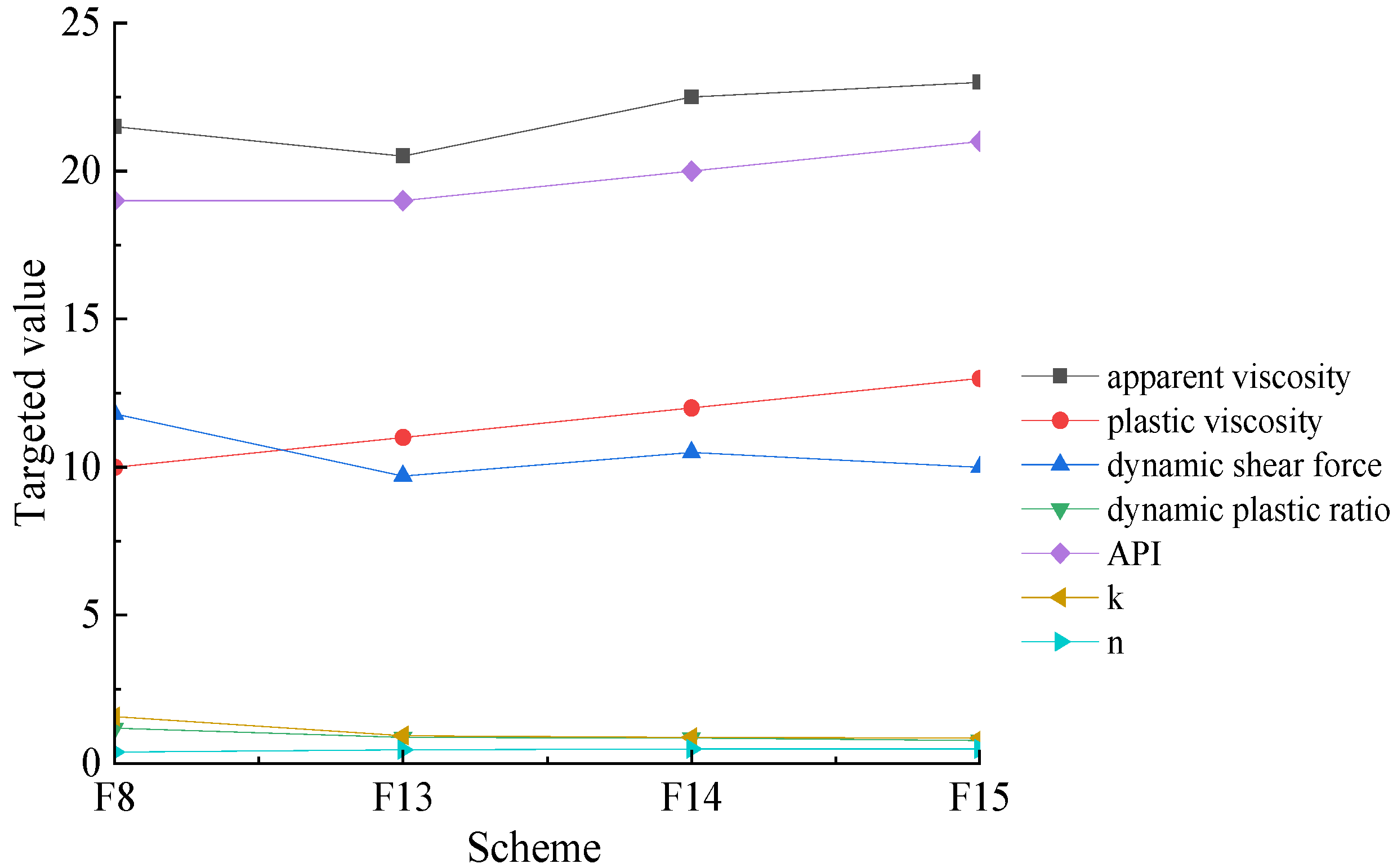


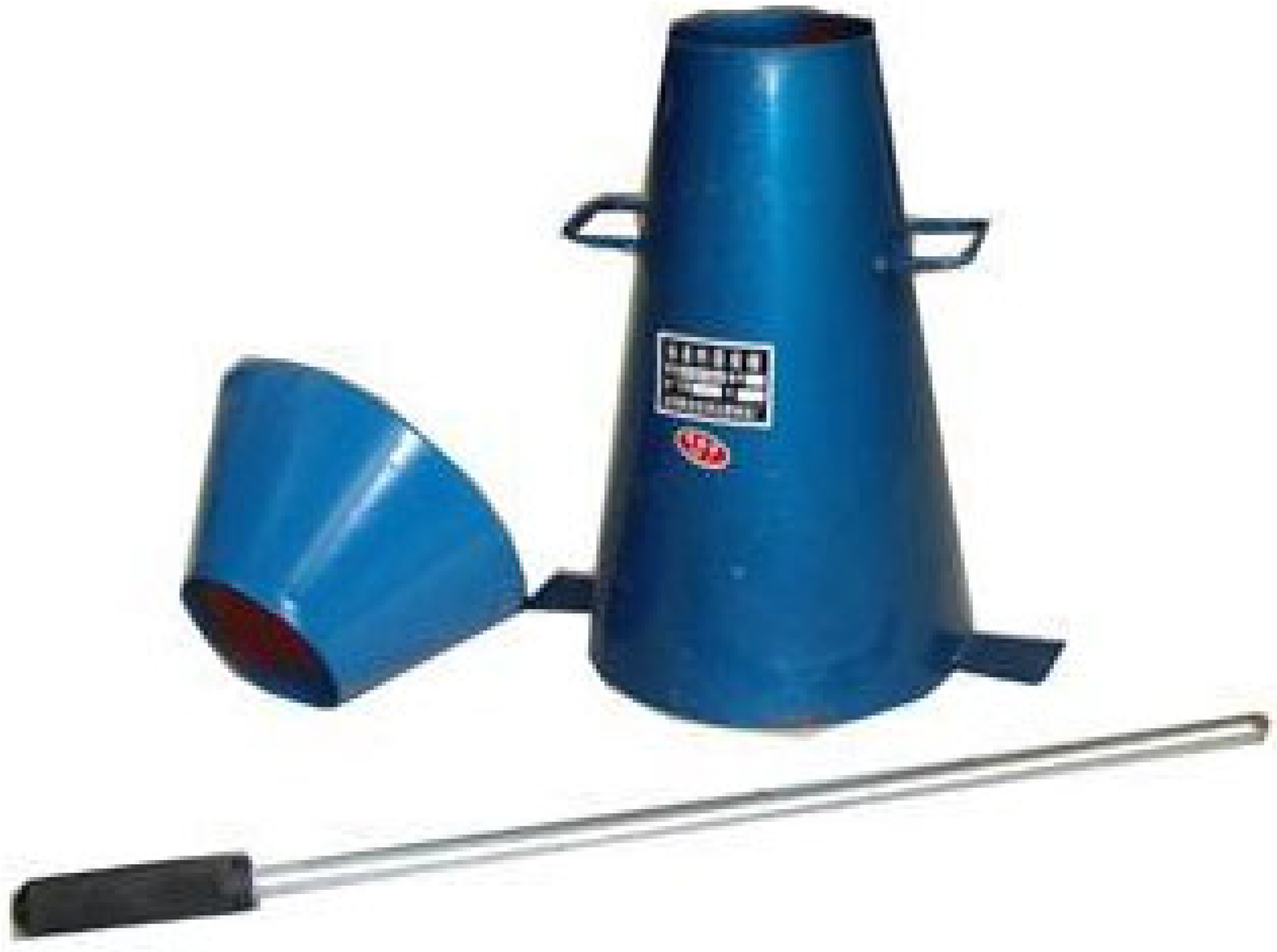
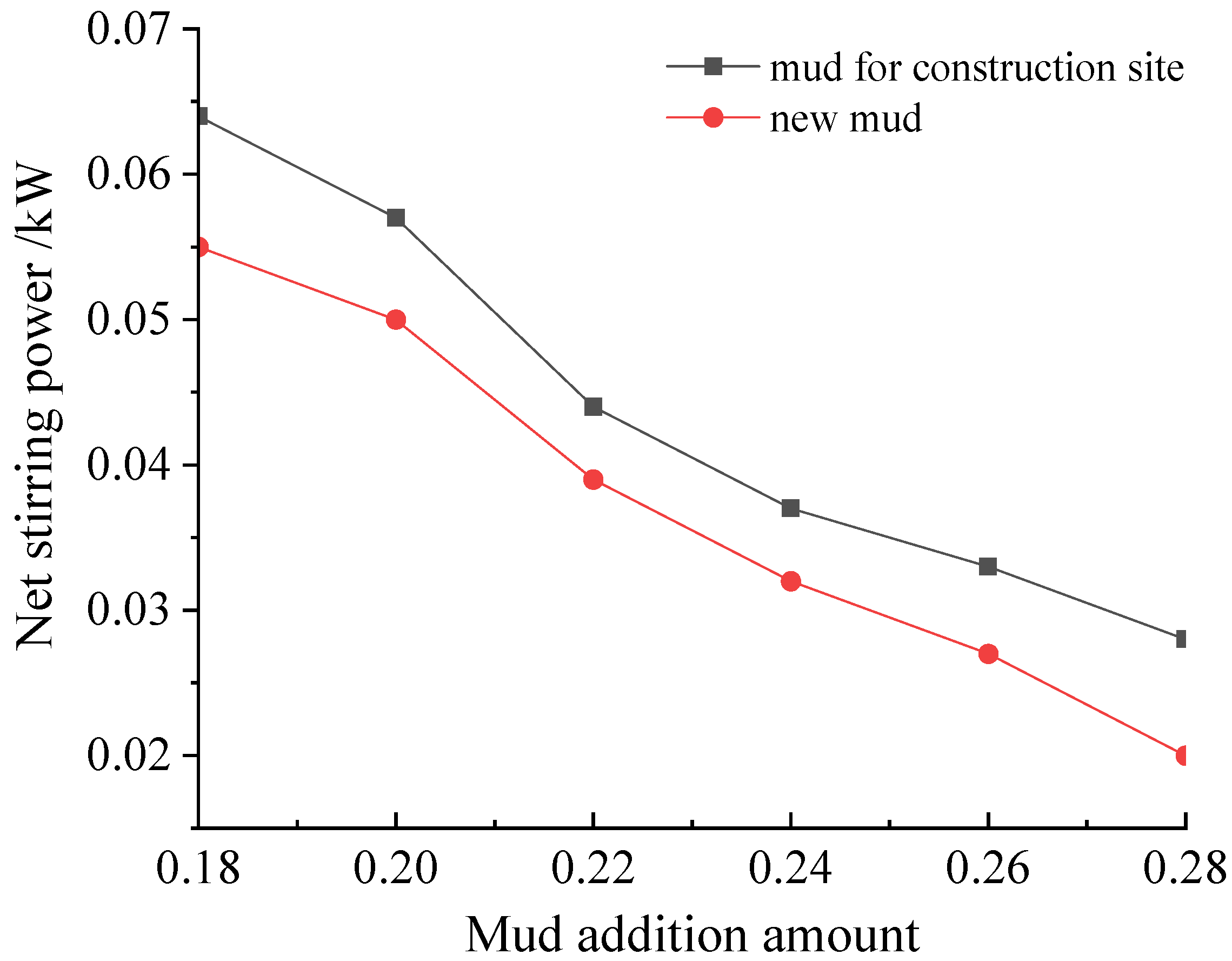


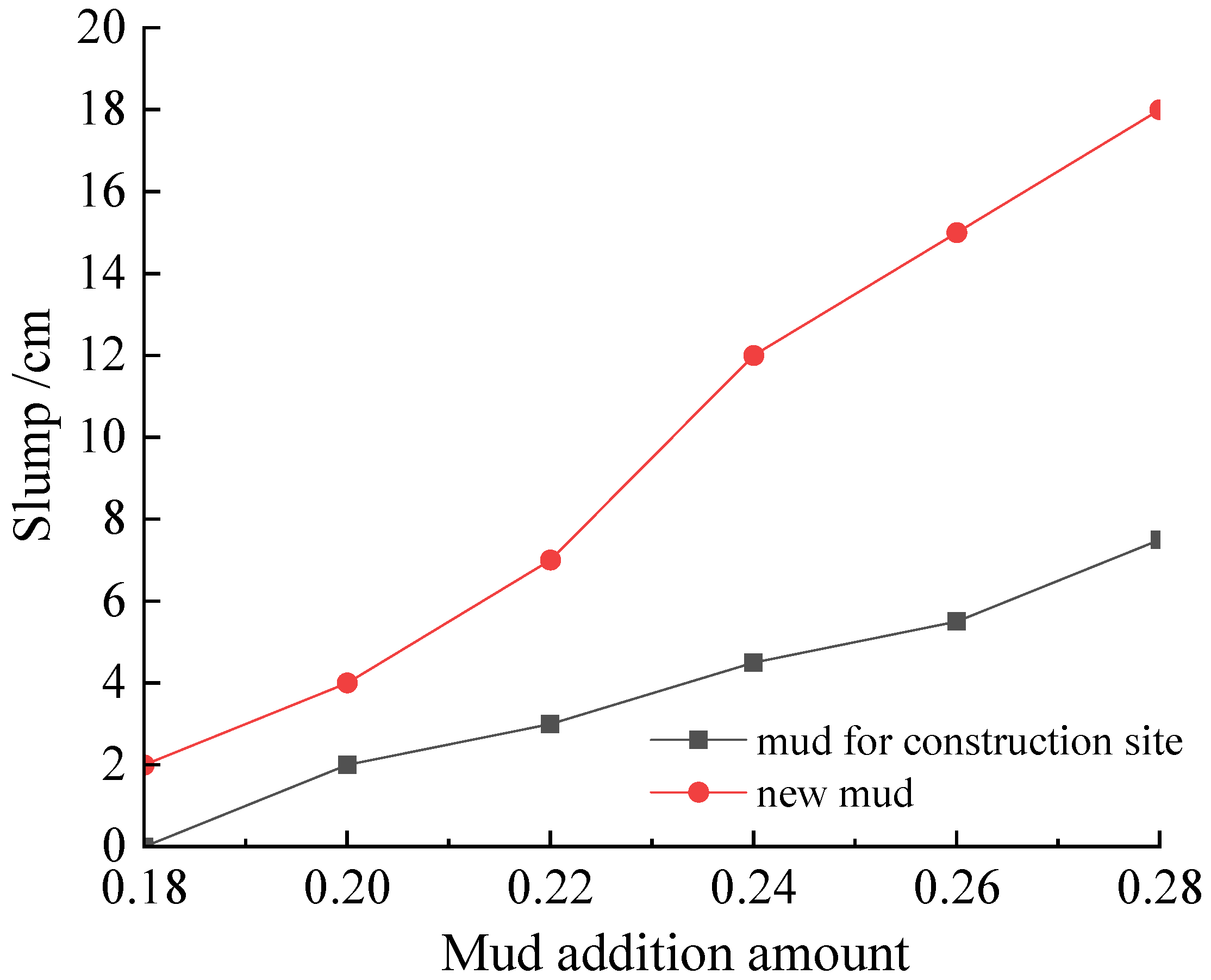
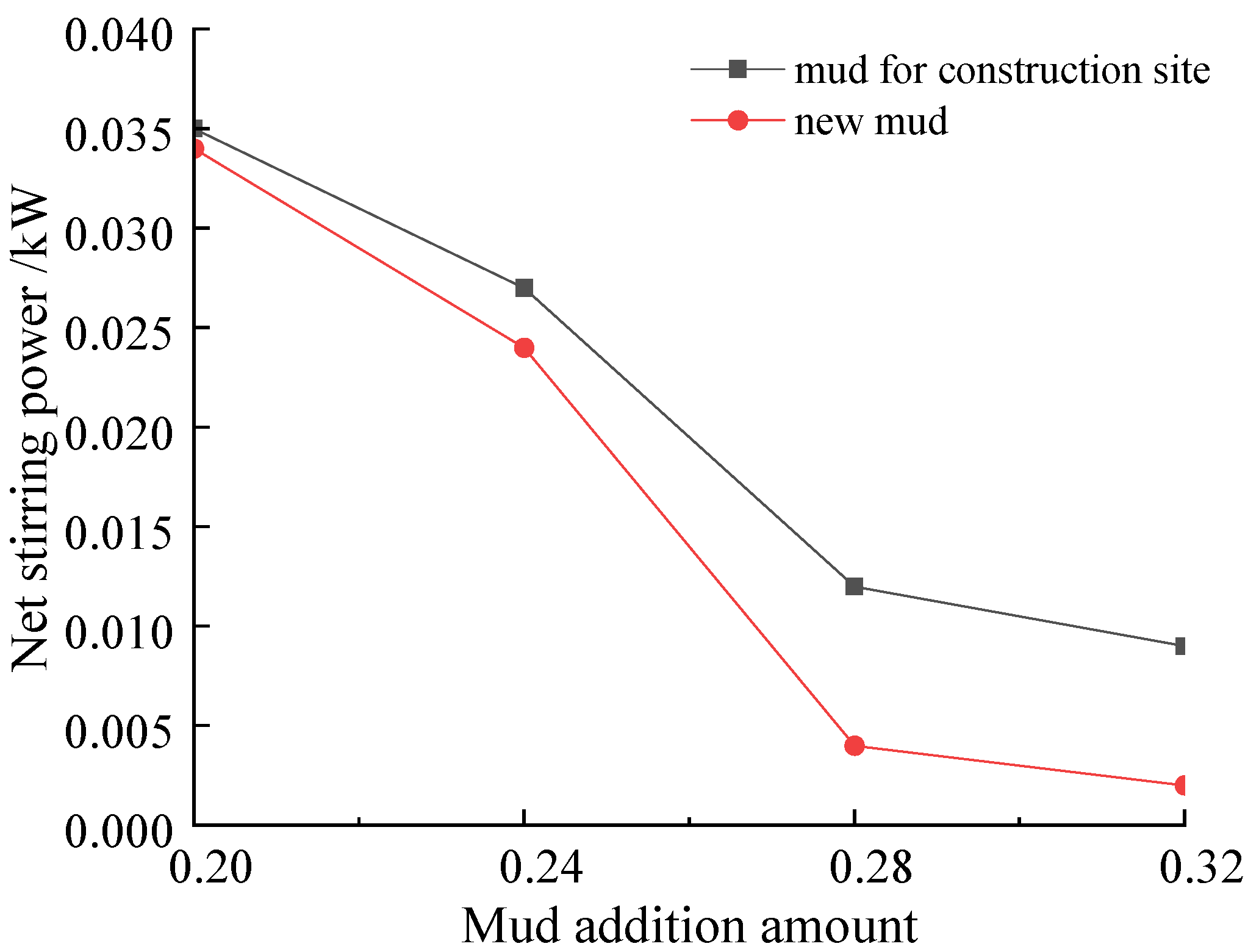
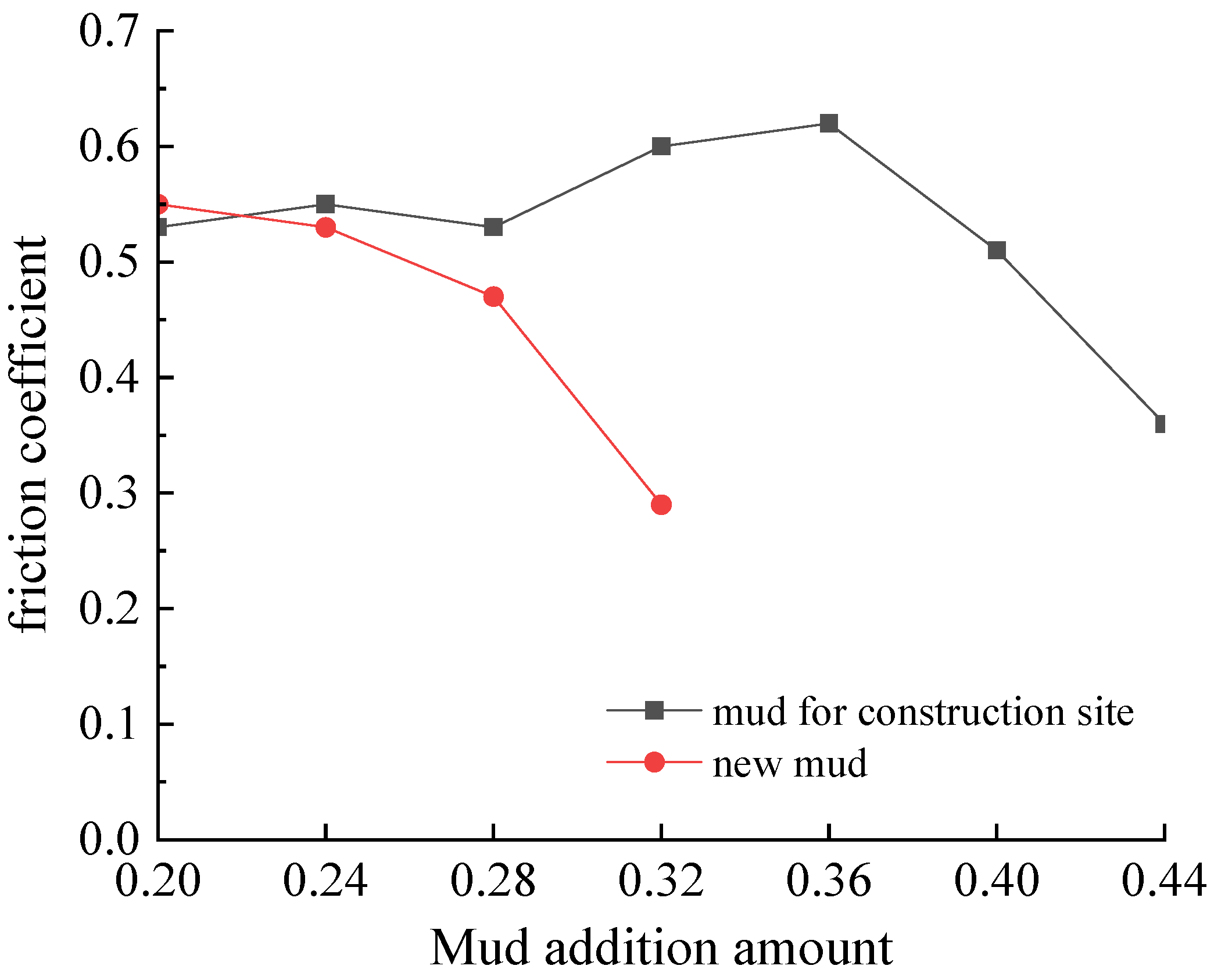
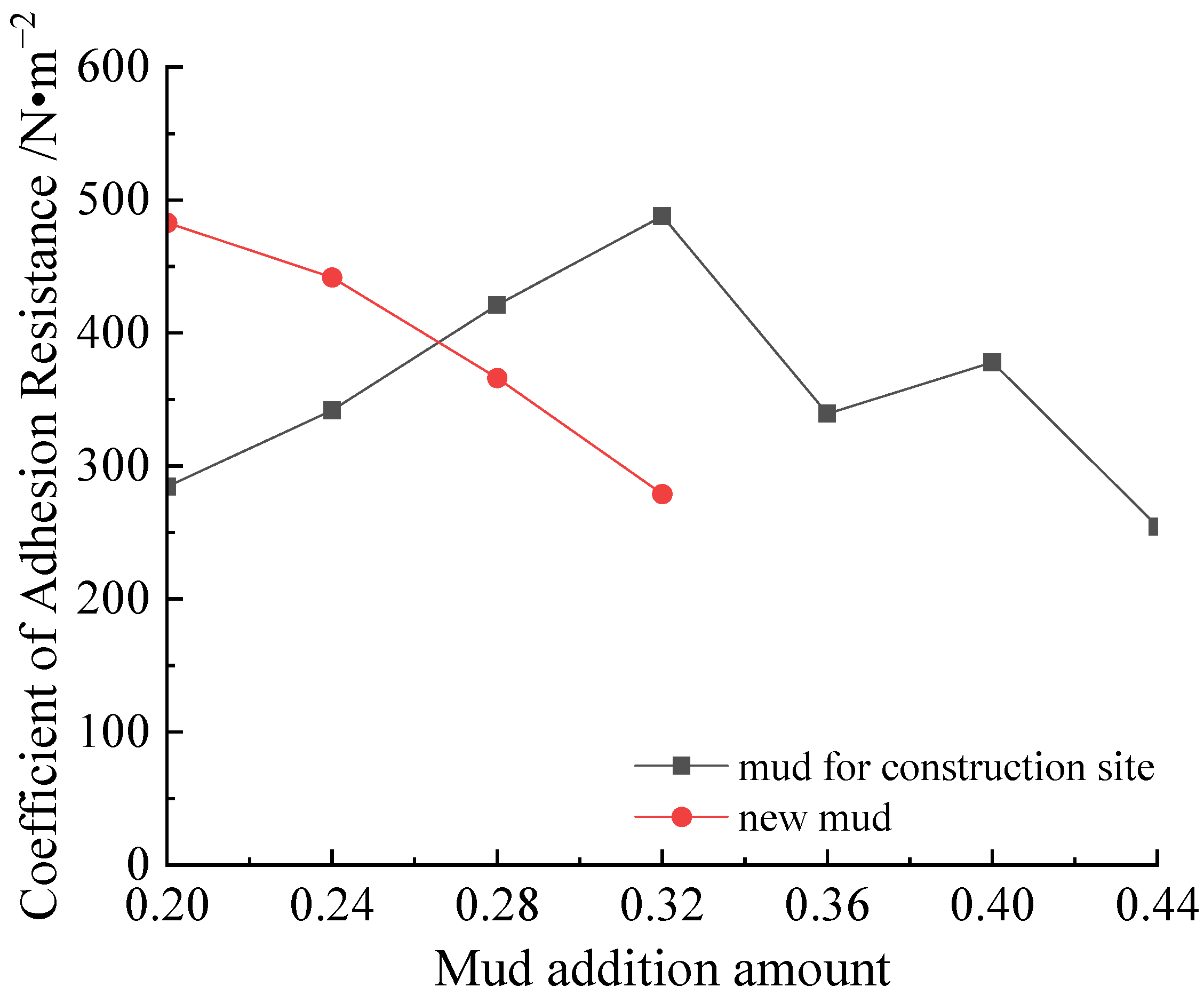

| Mud Performance Index | |||
|---|---|---|---|
| Density (g/cm3) | 1.04 | pH | 10 |
| Marsh funnel viscosity (″) | 40 | Static filtration (mL/30 min) | 21 |
| Apparent viscosity (MPa·s) | 13.5 | Plastic viscosity (MPa·s) | 3 |
| Dynamic shear (Pa) | 10.7 | Dynamic to plastic ratio | 3.6 |
| Initial static shear force (Pa) | 9.2 | Final shear force (Pa) | 10.7 |
| Liquidity Index | 0.17 | Consistency coefficient (Pa·sn) | 4.2 |
| Colloid rate | 90% | ||
| Drugs Scheme | Water (g) | Bentonite (g) | Sodium Carbonate (g) | Guar Gum (g) | Sodium Carboxymethylcellulose (g) | Xanthan Gum (g) | Polyacrylamide (g) |
|---|---|---|---|---|---|---|---|
| F1 | 1000 | 30 (4%) | 0.5 (0.05%) | 2 (0.2%) | / | / | / |
| F2 | 1000 | 40 (5%) | 0.5 (0.05%) | 2 (0.2%) | / | / | / |
| F3 | 1000 | 50 (3%) | 0.5 (0.05%) | 2 (0.2%) | / | / | / |
| F4 | 1000 | 30 (4%) | 0.5 (0.05%) | / | 2 (0.2%) | / | / |
| F5 | 1000 | 40 (3%) | 0.5 (0.05%) | / | 2 (0.2%) | / | / |
| F6 | 1000 | 50 (3%) | 0.5 (0.05%) | / | 2 (0.2%) | / | / |
| F7 | 1000 | 30 (3%) | 0.5 (0.05%) | / | / | 2 (0.2%) | / |
| F8 | 1000 | 40 (3%) | 0.5 (0.05%) | / | / | 2 (0.2%) | / |
| F9 | 1000 | 50 (3%) | 0.5 (0.05%) | / | / | 2 (0.2%) | / |
| F10 | 1000 | 30 (3%) | 0.5 (0.05%) | / | / | / | 2 (0.2%) |
| F11 | 1000 | 40 (3%) | 0.5 (0.05%) | / | / | / | 2 (0.2%) |
| F12 | 1000 | 50 (3%) | 0.5 (0.05%) | / | / | / | 2 (0.2%) |
| Scheme | AV (Mpa·s) | PV (Mpa·s) | YP (Pa) | Gelin Pa | Gel10 (Pa) | FL (mL) | K (Pa.sn) | n | Marsh Funnel Viscosity S | Colloid Rate (%) | YP/PV |
|---|---|---|---|---|---|---|---|---|---|---|---|
| F0 | 13.5 | 3 | 10.7 | 9.2 | 10.7 | 21 | 4.2 | 0.17 | 40 | 90% | 3.6 |
| F1 | 9 | 7 | 2.04 | 1.53 | 2.04 | 1.48 | 0.21 | 35 | 80% | 0.3 | |
| F2 | 15.5 | 10 | 5.6 | 2.6 | 3.6 | 0.33 | 0.56 | 38 | 80% | 0.56 | |
| F3 | 18 | 13 | 8.2 | 3.1 | 4.1 | 0.71 | 0.47 | 40 | 82% | 0.63 | |
| F4 | 9.5 | 8 | 1.53 | 1.53 | 2.04 | 19 | 0.04 | 0.79 | 36 | 99% | 0.19 |
| F5 | 14 | 11 | 3.07 | 2.04 | 2.56 | 18 | 0.10 | 0.72 | 41 | 99% | 0.28 |
| F6 | 18 | 13 | 5.11 | 3.57 | 4.09 | 17 | 0.20 | 0.65 | 54 | 99% | 0.39 |
| F7 | 14.5 | 7 | 7.67 | 4.09 | 6.13 | 21 | 0.93 | 0.40 | 47 | 99% | 1.10 |
| F8 | 21.5 | 10 | 11.8 | 7.67 | 9.20 | 19 | 1.58 | 0.38 | 61 | 99% | 1.18 |
| F9 | 26 | 9 | 17.4 | 8.69 | 9.20 | 17 | 2.82 | 0.33 | 94 | 100% | 1.93 |
| Drugs Scheme | Water (g) | Bentonite (g) | Sodium Carbonate (g) | Xanthan Gum (g) | Clay Particles (g) |
|---|---|---|---|---|---|
| F13 | 1000 | 40 (4%) | 0.5 (0.05%) | 0.5 (0.05%) | 5 (0.5%) |
| F14 | 1000 | 40 (4%) | 0.5 (0.05%) | 0.5 (0.05%) | 10 (1%) |
| F15 | 1000 | 40 (4%) | 0.5 (0.05%) | 0.5 (0.05%) | 15 (1.5%) |
| Scheme | AV (Mpa·s) | PV (Mpa·s) | YP (Pa) | Gelin (pa) | Gel10 (Pa) | FL (mL) | K (Pa.sn) | n | Marsh Funnel Viscosity S | Colloid Fraction(%) | YP/PV |
|---|---|---|---|---|---|---|---|---|---|---|---|
| F13 | 20.5 | 11 | 9.7 | 7.67 | 8.18 | 19 | 0.93 | 0.45 | 63 | 100% | 0.88 |
| F14 | 22.5 | 12 | 10.5 | 7.67 | 8.18 | 20 | 0.85 | 0.48 | 65 | 100% | 0.88 |
| F15 | 23 | 13 | 10 | 8.18 | 8.69 | 21 | 0.85 | 0.48 | 67 | 100% | 0.77 |
| Raw Material | Bentonite | Xanthan Gum | Sodium Carbonate | Clay Particles |
|---|---|---|---|---|
| Increase the amount | 4% | 0.2% | 0.04% | 1% |
| Particle Size(mm) | 60~20 | 20~5 | 5~2 | 2~0.5 | 0.5~0.25 | 0.25~0.075 | 0.075~0.005 |
|---|---|---|---|---|---|---|---|
| content(%) | 30 | 20 | 15 | 15 | 10 | 5 | 5 |
| Particle Size (mm) | 2~0.5 | 0.5~0.25 | 0.25~0.075 | 0.075~0.005 |
|---|---|---|---|---|
| Content (%) | 30 | 30 | 30 | 10 |
Publisher’s Note: MDPI stays neutral with regard to jurisdictional claims in published maps and institutional affiliations. |
© 2022 by the authors. Licensee MDPI, Basel, Switzerland. This article is an open access article distributed under the terms and conditions of the Creative Commons Attribution (CC BY) license (https://creativecommons.org/licenses/by/4.0/).
Share and Cite
Sun, Y.; Zhao, D. Research and Experimental Application of New Slurry Proportioning for Slag Improvement of EPB Shield Crossing Sand and Gravel Layer. Coatings 2022, 12, 1961. https://doi.org/10.3390/coatings12121961
Sun Y, Zhao D. Research and Experimental Application of New Slurry Proportioning for Slag Improvement of EPB Shield Crossing Sand and Gravel Layer. Coatings. 2022; 12(12):1961. https://doi.org/10.3390/coatings12121961
Chicago/Turabian StyleSun, Yongshuai, and Dongjie Zhao. 2022. "Research and Experimental Application of New Slurry Proportioning for Slag Improvement of EPB Shield Crossing Sand and Gravel Layer" Coatings 12, no. 12: 1961. https://doi.org/10.3390/coatings12121961
APA StyleSun, Y., & Zhao, D. (2022). Research and Experimental Application of New Slurry Proportioning for Slag Improvement of EPB Shield Crossing Sand and Gravel Layer. Coatings, 12(12), 1961. https://doi.org/10.3390/coatings12121961






